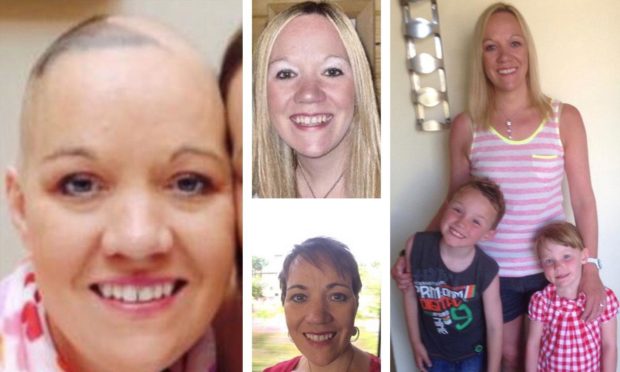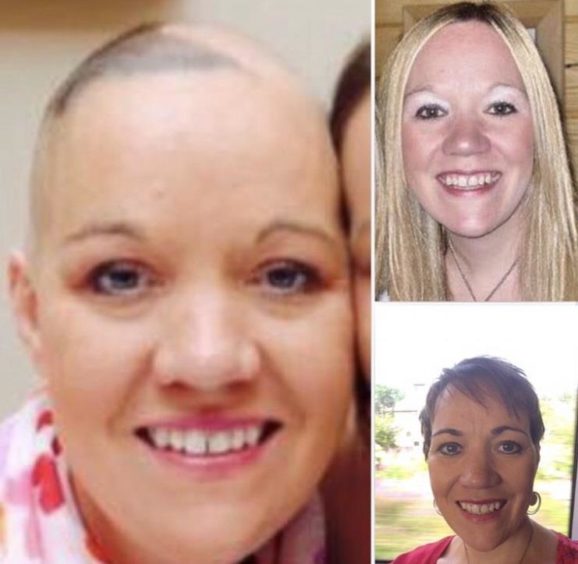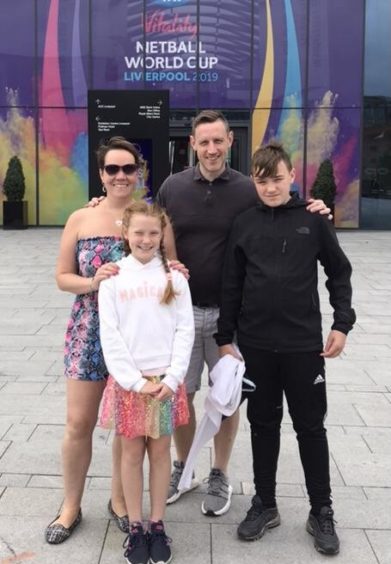An Aberdeenshire mum embracing a new trial of a cannabis-based drug which aims to give people with aggressive brain tumours a longer life.
The drug, an oral spray called Sativex, would be added to chemotherapy treatment for those living with a recurrent glioblastoma brain tumour.
Suzanne Davies, from Newtonhill, is someone whose life could be hugely impacted by this trial after first being diagnosed in 2014 – and told she only had 12-18 months to live.
The 43-year-old first noticed something wasn’t right when she struggled to understand a system at work, was temporarily unable to speak and move as she usually would, started experiencing headaches and was waking up in the night with the sensation that she was unable to breathe.
She underwent an awake craniotomy which found a tumor the size of a golf ball.
Surgeons removed as much of the tumor as they could and confirmed it as grade four glioblastomia.
Mrs Davies said: “It all happened so incredibly quickly as the symptoms came on so fast and, before I even could process it all, I was having the surgery to save my life.
“I was worried about the kids as they were only four and seven years old at the time. So, I just did what I had to do and tried to think positive about it all.
“If someone had told me a month before that I had cancer, that this would be happening then I wouldn’t have believed them.”
She emphasised the importance of her husband and support system throughout her journey with cancer: “My husband, Owen, has been my ‘rock’ throughout. He has been so brilliantly supportive of me and our children and he has done all he possibly could do to keep me safe.”
Seven years on
Seven years later, Mrs Davies’ condition is stable, though she takes daily medication and lives with long-term side-effects including memory problems and seizures.
Despite the odds, she continues to have a positive outlook on life and her situation: “I really do think that this happened to me at the right time and that it was for good reason.
“The diagnosis totally changed my outlook on life.
“Instead of just battling on with the everyday, I now wake up in the morning and think to myself ‘here’s another day to enjoy’ and I am grateful for that.
“I have never once thought ‘why me?’ because something like this can happen to anyone.”
Mrs Davies is dedicated to raising awareness so that other people like her can notice their symptoms early.
Along with her family, she has also raised over £40,000 for various cancer charities.
She hopes the Sativex trial could mean a more positive outlook for those living with glioblastoma.
She said: “I am not sharing my story because I want people to feel sorry for me but I truly believe that more people need to know about and understand brain tumours and the impact which they can have.
“I have been waiting for seven years to find a cure for grade four glioblastomas.
“There’s so many people like me really want to see trials like this go ahead – the potential it has to change our lives could be absolutely wonderful.”
Sativex
Sativex, which contains cannabinoids THC and CBD, has already undergone one round of trials.
The first trial proved that it was compatible with chemotherapy.
This second trial is run by The Brain Tumour Charity, who hope to launch the new drug at 15 NHS hospitals.
To do this they need to raise £450,000, and if they do so, they want to recruit 230 patients to trial the drug in early 2022.
Dr David Jenkinson, interim chief executive at The Brain Tumour Charity, said: “We hope this trial could pave the way for a long-awaited new lifeline that could help offer glioblastoma patients precious extra months to live and make memories with their loved ones.
“We know there is significant interest about the potential activity of cannabinoids in treating glioblastomas, and we’re really excited that this world-first trial here in the UK could help accelerate these answers.
“But we also know that for many, like the Davies family, this trial won’t come soon enough.”
“Cannabinoids have well-described effects”
Professor Susan Short, professor of clinical oncology and neuro-oncology at Leeds University is leading the new trial.
She hopes it will help to shine more light on the impact of cannabidoids on cancerous cells.
She said: “The treatment of glioblastomas remains extremely challenging. Even with surgery, radiotherapy and chemotherapy, nearly all of these brain tumours re-grow within a year, and unfortunately there are very few options for patients once this occurs.
“Cannabinoids have well-described effects in the brain and there has been a lot of interest in their use across different cancers for a long time now.”
Ms Short has high hopes for the trial and hopes it will finally provide some answers regarding the best treatment of this form of tumour.
She said: “It’s really exciting that we’re now at the point where we can run a definitive, well-designed study that will tell us the answer to whether these agents could help treat the most aggressive form of brain tumour.
“Having recently shown that a specific cannabinoid combination given by oral spray could be safely added to temozolomide chemotherapy, we’re really excited to build on these findings to assess whether this drug could help glioblastoma patients live longer in a major randomised trial.”


